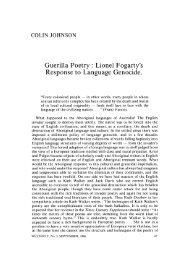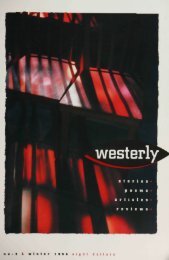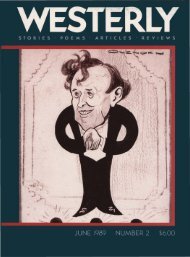added dimension of individual human personality—thehead we see of Baudelaire with itsfalling lock could be none other than that of asymbolist poet. In this insistence on naturalismhe seems to remind us that in the act of creationGod had beauty in mind. His sensualityis characteristically Gallic: the act of love isdepicted with infinitely graceful and tendergestures. No man has been able to convey thebeauty of human movement so well: athletes,bathers, dancers have always attracted artists,and particularly the imaginations of many ofthe painters who were Rodin's contemporaries,but Rodin gives an unexcelled dimension ofvitality to his studies of motion. And in hisgreat tableaux he found inspiration to depictthe infinite range of human emotion; in theattitudes and the miens of the "Burghers ofCalais", and the multiplicity of figures andfigurines to be seen in the "Gate of Hell" arereflected sorrow, despair, joy, anguish, hope,tenderness, such as in a lifetime Corneille andShakespeare were together not able in poetryto portray with such comprehension.In short, Rodin refreshes, enriches, and enlightensus; like all very great artists he opensour eyes to new perspectives, interpretationsand dimensions of experience; and he remindsus that our business, in art and taste and inscience, is to be satisfied with nothing less thanthe first rate, and that we can never be donewith striving to achieve possible perfection.66"Property is the fruit of labour.Property is desirable.It is a positive good in the world."Abraham Lincoln,25 March 1864.KEMPTON, MORRILL & CO.REAL ESTATE AGENTS31 HAMPDEN ROAD, HOLLYWOOD86 4819who are happy to extend their bestwishes for the continuing success of"<strong>Westerly</strong>".PORTRAITS OF PLACESPerth Sketchbook: Text by Kirwan Ward,drawings by Paul Rigby, Rigby $1.95.The Rocks Sydney: Drawings by Unk White,text by Olaf Ruhen, Rigby $1.95.Paul Rigby's nervous line is happiest with theincredible gingerbread and fairy floss of thefacade of His Majesty's Theatre and with theshadows and capitals of the front of St.George's Hall; even so, he catches beautifullynot merely the style but also the feel of Perth's—too few—interesting old buildings, plain andfancy aUke. And though his view of St.George's Cathedral does less than justice to itsexcellent proportions and attractive siting, mostof his pictures will serve not merely as records,but as images; images which will make localpeople look again, and more perceptively, atthe agreeable old buildings they have aboutthem. And they had better look, while there isstill time.Kirwan Ward's text is, like his column, fullof fact and opinion neatly spliced, and hespares neither the planners nor the Parliamentarians,the licenced vandals of the twentiethcentury their hot little hands always on theirhammers. Buy a copy of the Sketchbook foryour grandchildren, it may be all the old Perththey'll have to look at; the score so far is only'one down, twenty-one to go', but one wondershow many of the survivors are really safe: theFremantle Asylum is, and the University nodoubt: the rest . . . ?One is glad to note that Perth's biggest bitof pure bogus is not recorded in the Sketchbook:there is no view of London Court; norfor that matter of Parliament House facade.The Rocks, Sydney, provide enough to filla book the same size as Perth Sketchbook, andUnk White's drawings, their delicate washescoming across as soft and various greys, arelabours of love, beautifuly accurate and tremendouslyatmospheric.Iron lace and junk on wash-house roofs bothget in, and both contrive to look decorative—here Romanticism triumphs over truth nodoubt, but one is charmed all the same. Indeed,charm, of a Victorian or at least Edwardiansort, is precisely what these pictures intheir demode style share with their subjects.And even in a city with some real seriousRegency, simply charming buildings have theirvalue.Olaf Ruben's text contains a great deal ofinteresting and for all I know accurate information;the style is beyond comment.Patrick HutchingsWESTERLY, No. 1 of 1967
A Joyless World: The Fiction of Peter Cowan,by Grahame Johnston.The publication in the last two years of athird volume of short stories by Peter Cowan,entitled The Empty Street, and a second novel,Seed, increases in substance, though not markedlyin variety, the oeuvre of one of Australia'smost careful writers of fiction.We have often been told by critics that it istime that serious novelists forsook rural themesand concentrated on the city life of one of theworld's most urbanised peoples. We have alsobeen told that it is a want of art, or at leastcraft, which has derogated from the power ofmuch of our prose. These charges weigh lessheavily than they once did, not least becauseof the recent writings of Patrick White, whatevervaluation one places upon them.And yet it is principally in relation to demandsof this sort that one assesses the workof Peter Cowan: for here in his stories is mundaneAustralia (especially Perth and WesternAustralia) with its ordinary people and quotidiandoings shaped into tidy, spare narratives.The locales are recognisable, even at timesevocative; the people credible if not alwayscomprehensible; the stories equally credible ifat times violent. Peter Cowan's world exists.It is a curiously joyless world; and in consideringwhy this is so one perhaps finds amethod of determining why, despite all thatthere is to be grateful for in his fiction, itremains strangely and persistently unsatisfying.The plain monotone of Mr Cowan's understatedprose often fits very well the charactersand actions of his stories, and it is clearlyintended to accord with what the author perceivesas the dullness, monotony, and eventhe despair of their lives. Peter Cowan thinkswell of Nature and the unspoilt beauty of thebush, he admires the natural impulse and theyouthful, unforced response; by contrast hehates cities, the spoliation wrought by "developers',and the artificial, compromised life ofthe adult. On this simple opposition nearly allof his stories and novels are structured; andthe end of all, or at least the burden of all,is that we are all finally defeated.A message of this kind—and occasionallythe tone of the preacher is so evident in MrCowan's work that the language of evangelismis all too apt—needs to be conveyed withpower if it is to dent the traditional Australianoptimism, and needs to draw out of commonevents their essential tragedy. Mr Cowan, inmy judgment, rarely manages this, and thereason—or one of the reasons—is that he toorarely quickens our sympathies. To see a greatsorrow, there must be joyfulness nearby, or atleast remembered; to feel tragedy, we must beconvinced of waste or grief. But Mr Cowan,for all his careful craftsmanship, cannot engageus to suffer or weep.On the dust-cover of Ttie Empty Street thepublishers have reproduced Robert Dickerson'spainting, 'Boy in a Street'; and the associationof story and picture holds good for most ofPeter Cowan's work: the true analogy to histales is the painting of Drysdale, Dickerson,and the other delineators of a dry and sombreland. Somehow, though, the stories lack theforce of the paintings, and seem contrived incomparison. To use the word 'contrived' isagain to make what seems to be a necessarilylimiting judgment about Peter Cowan's writings.Reading his short stories, in particular, oneis conscious that he is working in the sparemodern style, and reminded of figures UkeHemingway behind him. The sentences areusually short, declarative, uncomplicated; thedescriptions are bare, orderly, functional. Muchskill goes into writing of this sort, and to befair one must say that Mr Cowan has donewell to follow these masters. But there is abouthis prose a deadness (on the one hand) anda novelettish quality (on the other) which oftenbetray him.In the stories of Hemingway, even the inferiorones, we are aware that the apparentlysimple prose is in fact a very sophisticatedinstrument capable of a wide range of effects:of his style one might say, with Mies van derRohe, 'Less is more'. This is especially truewhen Hemingway is evoking the feel, soundand smell of objects—^the cold trout streamsup in Michigan, the poplars in Lombardy, thefogged-up windows of the bistros—and gratifyingour senses. The firm, straightforward sentencesgive order to a series of sensations.In Peter Cowan's stories there is no suchvariety. True, in the dry, level landscapes inwhich many of them are set, it is doubtlessauthentic that heat, dust, haze, shadow andextreme light are our dominant impressions,but his evocation of these settings is not aseffective as (for instance) Randolph Stow's.The shrieking cockatoos of The Bystander remainin the memory; not so the birds of 'TheHouse' (the first story in The Empty Street).The life of his characters, Mr Cowan oftensuggests, is only an existence, a dull followingof routine; they are, in truth, dead. This deadnessis all too prevalent, for it extends to theprose in which the stories are narrated.And yet at times Mr Cowan attempts alarger flight, a deeper analysis of the motivesWESTERLY, No. 1 of 1967 67
- Page 1 and 2:
arc de triomphe
- Page 3 and 4:
westerlya quarterly reviewEDITORIAL
- Page 5:
westerlyNo. 1 of 1967CONTENTSSTORIE
- Page 8 and 9:
"Oh, old Jack's morals are alright
- Page 10 and 11:
were looking down on a face so scru
- Page 12 and 13:
in the comfort of cars. Ellie and T
- Page 14 and 15:
grand, final fling. His bright eyes
- Page 16 and 17:
The rotting wood in the window fram
- Page 18 and 19:
John lumbered up the steps of the G
- Page 20 and 21:
night storm that flashed and twinkl
- Page 22 and 23: Quietly the young man left to fetch
- Page 24 and 25: "Bother, I've forgotten your aktavi
- Page 26 and 27: patiently as she hesitated. What wa
- Page 28 and 29: THEUNIVERSITYBOOKSHOPAT THE UNIVERS
- Page 30 and 31: PREFACE(Emaux et Camees)Pendant les
- Page 32 and 33: NOELLe ciel est noir, la terre est
- Page 34 and 35: LA DERNIERE FEUILLEDans la foret ch
- Page 36 and 37: LES COLOMBESSur le coteau, 1^-bas o
- Page 38 and 39: LA MONTREDeux fois je regarde ma mo
- Page 40 and 41: FUMEELa-bas, sous les arbres s'abri
- Page 42 and 43: PENDANT LA TEMPETELa barque est pet
- Page 44 and 45: PAYSAGEPas une feuille qui bouge,Pa
- Page 46 and 47: LE MERLEUn oiseau siffle dans les b
- Page 48 and 49: LETRILLAEnfant, pourquoi tant de pa
- Page 50 and 51: L'ARTOui, I'oeuvre sort plus belleD
- Page 52 and 53: ARTYes, lovelier do works of artEme
- Page 54 and 55: Some JOURNALS published byUNIVERSIT
- Page 56 and 57: But the two Town Planners did not j
- Page 58 and 59: The years 1963-65, therefore, were
- Page 60 and 61: COCD00(Moasu;-(a!CocP4Q
- Page 62 and 63: •OS. ^ " ^-«w" 1 a 1-1* r^^ril1
- Page 64 and 65: —representing one home in about 5
- Page 66 and 67: ingly in the determination of its p
- Page 68 and 69: For a personal view. Westerly asked
- Page 70 and 71: Abrolhos Islands, is believed to ha
- Page 74 and 75: and feelings of his people or of th
- Page 76 and 77: theological developments of the las
- Page 79 and 80: IF YOU DON T KNOW HOWDON'T DO IT•







